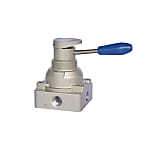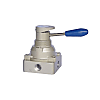(!) Since support from Microsoft will end on January 14 2020, Windows 7 user might not be able to use MISUMI website effectively. Please consider to update your system as ‘MISUMI Website system requirement’.
- แจ้งวันหยุดทำการในเดือน กรกฎาคมและสิงหาคม 2567 | Notice holiday in July and August 2024 > คลิก
AIRTAC Hand Valves(How to Mount:Bottom)
AIRTAC offers products Hand Valves specified by How to Mount Bottom from Automation Components product category. There are a total of 1 items. Search and select detailed specifications of parts for your machine with free CAD downloads. AIRTAC products are available to order through MISUMI online 24 hours a day. Free shipping, no minimum order.
Configure
Specification/Dimensions
-
Connecting Tube Diameter
- Ø4
- Ø6
- Ø8
- Ø10
- Ø12
- 1/4
- 5/16
- 3/8
- 1/2
-
Number of Ports
- 2-Port
- 3-Port
- 4-Port
-
Switching Operation
- Manual Lever
- Knob
- Selecting Knob
- Others
-
Effective Sectional Area(mm2)
- 1.48
- 1.84
- 2.5
- 2.58
- 3.4
- 3.5
- 3.8
- 3.87
- 4
- 5.0
- 5.35
- 5.5
- 6.0
- 6.46
- 6.64
- 7.0
- 7.2
- 7.5
- 7.7
- 8
- 8.1
- 8.2
- 8.3
- 8.4
- 8.5
- 8.6
- 8.67
- 8.7
- 8.8
- 8.9
- 9
- 9.5
- 10.15
- 10.3
- 10.5
- 11
- 11.5
- 11.99
- 12
- 12.18
- 12.5
- 12.55
- 12.92
- 13
- 13.10
- 14.39
- 15.4
- 15.6
- 15.68
- 15.7
- 15.8
- 16
- 16.1
- 16.2
- 16.3
- 16.5
- 16.6
- 16.8
- 16.9
- 17
- 17.1
- 17.4
- 17.5
- 18
- 18.1
- 18.5
- 20.30
- 20.5
- 22
- 22.99
- 23
- 23.06
- 23.98
- 24
- 24.5
- 26
- 27.67
- 30
- 33
- 34.5
- 35.5
- 36
- 38.19
- 39
- 39.5
- 40
- 41
- 44
- 45.5
- 46
- 47
- 49
- 51.5
- 53.50
- 54
- 55
- 55.5
- 57.20
- 62.11
- 62.73
- 64.58
- 68.26
- 70.11
- 79.34
- 83.02
- 88
- 95
- 101.41
- 114
- 118
- 140
- 258.30
- 276.75
-
Main Body Shape
- Block Horizontal Type
- One-Touch Fitting Type
- Pin Shape
- Others
-
Pipe Port Type
- M
- Rc (R)
- NPT
- G
- One-Touch Plumbing
- Others
-
Number of Switching Positions
- 2-Position Normally Open
- 2-Position Normally Closed
- 2-Position Exhaust
- 3-Position Closed Center
- 3-Position Exhaust Center
- 2-Position Direction Switching
- Others
-
Plumbing Thread Nominal
- M5
- 1/8
- 1/4
- 3/8
- 1/2
- 3/4
- 1
-
Plumbing Type and Direction
- Direct Side Surface
- Direct Bottom Surface
- Others
-
Effective Sectional Area【classification】(mm2)
* ~10 represents over 5, and 10 or less.
-
How to Mount
Brand |
|
|---|---|
| CAD |
|
- 1 items
- Sort By
-
You can add up to 6 items per a category to the compare list.



Hand Valve (2 Position 4-Port, 3 Position 4-Port) 4HV, 4HVL Series
AIRTAC
[Features]
・ Accurate localization and improved operability.
・ Large effective distribution area, low pressure loss.
・ 2 types of mounting, panel mounting or bottom mounting, can be selected. With mounting screws for panel mounting.From: ฿ 477.00 Days to Ship: Same day
Same day
| Brand |
|---|
| Product Series |
| CAD |
| From |
| Days to Ship |
| Connecting Tube Diameter |
| Number of Ports |
| Switching Operation |
| Effective Sectional Area(mm2) |
| Main Body Shape |
| Pipe Port Type |
| Number of Switching Positions |
| Plumbing Thread Nominal |
| Plumbing Type and Direction |
| Effective Sectional Area【classification】(mm2) |
| How to Mount |
You can add up to 6 items per a category to the compare list. | |
| Brand | AIRTAC |
| Product Series | Hand Valve (2 Position 4-Port, 3 Position 4-Port) 4HV, 4HVL Series |
| CAD |
|
| From | ฿ 477.00 |
| Days to Ship | Same day |
| Connecting Tube Diameter | - |
| Number of Ports | 4-Port |
| Switching Operation | Manual Lever |
| Effective Sectional Area(mm2) | 16 ~ 95 |
| Main Body Shape | Block Horizontal Type |
| Pipe Port Type | Rc (R) |
| Number of Switching Positions | 3-Position Closed Center / 2-Position Direction Switching |
| Plumbing Thread Nominal | 1/4 / 3/8 / 1/2 / 3/4 |
| Plumbing Type and Direction | Direct Bottom Surface |
| Effective Sectional Area【classification】(mm2) | ~20 ~ ~100 |
| How to Mount | Bottom |
Loading...
Application example related to this category
Related Categories to Hand Valves
FAQ Hand Valves
- Question: What is a hand valve and its functions?
- Answer: A hand valve is a manually operated device used to control the flow of fluid (liquids or gases) in a system. It consists of a handle or lever that, when turned, adjusts the position of an internal mechanism to either open or close the valve. Hand valves serve to regulate fluid flow, isolate sections of a pipeline for maintenance, and control pressure. They find application in various industries such as plumbing and industrial processes.
- Question: When should you use the hand valve?
- Answer: Use a hand valve when manual control of fluid flow is necessary. It's employed to start, stop, or adjust flow rates in systems requiring human intervention, such as emergencies, maintenance, or precise adjustments. Hand valves are useful when automation isn't feasible, during equipment servicing, or when immediate response to changes is needed. They offer a simple and reliable means of flow regulation in various industries.
- Question: What are the advantages and disadvatages of hand valves / manual valves?
- Answer: Advantages of hand valves (manual valves) include simplicity, reliability, and cost-effectiveness. They offer precise control and immediate response during emergencies or maintenance, making them suitable for small-scale applications. However, they can be slower to operate compared to automated valves, require physical presence for adjustments, and might not be suitable for large-scale or continuous processes. Additionally, potential human error in operation and limited remote control are notable disadvantages.
- Question: What are the common materials used for valves?
- Answer: Hand valves are commonly constructed from materials such as brass, stainless steel, cast iron, bronze, and plastic (such as PVC or CPVC). The choice of material depends on factors like the type of fluid being handled, pressure requirements, temperature conditions, and corrosion resistance. These materials ensure durability and compatibility with various applications across industries like plumbing, industrial processes, and water treatment.










How can we improve?
How can we improve?